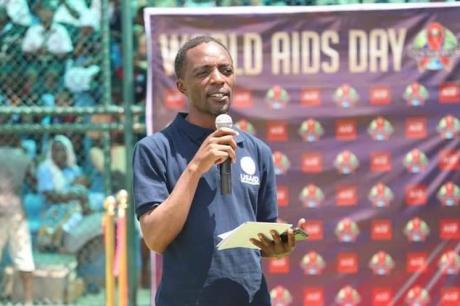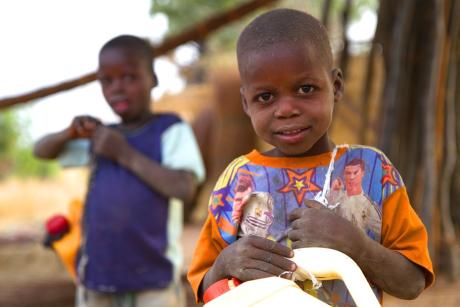
Toddler with microcephaly receiving physical therapy. Photo credit: Sumaia Villela/Agência Brasil, via Wikimedia Commons.
Published April 4, 2017, last updated on June 3, 2020 under Research News
A commentary by DGHI affiliates Michel Landry and Janet Prvu Bettger
For most of us, the word “Zika” instantly conjures up the image of an infant with an abnormally small head caused by microcephaly, being held by a distraught parent in South America. But many of the common symptoms of congenital Zika syndrome—and the resulting neurological and developmental complications—will stay with those babies throughout their entire lives. In addition to microcephaly, these symptoms range from brain and eye anomalies to orthopedic issues such as club foot and joint problems.
And it’s not just infants who develop serious effects from contracting Zika. Adults can develop debilitating neurological conditions such as Guillain-Barré syndrome, which can subside after a few weeks or cause life-limiting muscle weakness that continues for years.
Zika is rarely deadly, but it leads to a great deal of functional limitation and other disabilities. While tremendous inspirational progress is being made in developing vaccines, we must protect against the tendency to focus only on prevention and a cure for the infection. We must also invest in comprehensively addressing the health impact on those affected. Millions of children and adults with Zika-related disabilities will require long-term interventional, social and disability management—a set of needs that has received little attention to date.
Vaccines and Improved Diagnostics Aren’t Enough
The current spike in disability-related complications subsequent to Zika infection represents a critical need and opportunity for rehabilitation health professionals, including physical therapists, to enter the treatment equation. For most, if not all, of the neurological outcomes reported thus far, evidence suggests that targeted interventions have a positive overall effect of minimizing impairments, maximizing function and improving overall quality of life.
Until we have more evidence regarding the management of infants and children with congenital Zika syndrome, rehabilitation professionals can draw on their expertise and adapt intervention strategies used with children affected by other congenital infections, such as cytomegalovirus. Similarly, when working with adults with neurologic and orthopedic Zika-related limitations, rehabilitation health professionals can integrate their expertise, best evidence and patient values and preferences.
Zika Patients in Low-Resource Settings Are Likely to Face Barriers
Unfortunately, the people who are most likely to experience Zika-related disabilities are also the least likely to receive the recommended medical and rehabilitation care. Limited financial resources and lack of access to qualified specialists are distinct barriers to obtaining these services. In addition, families may face stigmatization of people with disabilities, further complicating their pursuit of treatment.
These challenges—along with an existing evidence base for strategies and the need to combat negative community attitudes toward people with disabilities—must be considered when developing and implementing effective institutional and community-based rehabilitation services to maximize the quality of life for those affected by Zika.
WHO and CDC Declarations Support Investment in Rehabilitation Services
Decisions and statements made by leading public health organizations also reflect a recognition of these long-term considerations for those infected by Zika.
For example, in February 2016, the World Health Organization declared Zika virus a public health emergency, not because of a threat of rapid transmission and deadliness, but rather because of its potential to cause devastating long-term morbidity and disability. And Thomas Frieden, director of the Centers for Disease Control and Prevention (CDC), warned that without collective action to contain the spread, the United States population “will likely be dealing with this for decades to come.”
A year later, in February 2017, the World Health Organization released “Rehabilitation 2030: A Call to Action,” recognizing the magnitude and scope of unmet rehabilitation needs and the need for coordinated global action to improve access and affordability for rehabilitation. Stakeholders from both infectious disease and rehabilitation circles must work together to achieve effective health outcomes for individuals affected by Zika.
Is there a silver lining in the Zika cloud?
Without a doubt, we must continue to put in place preventive mechanisms to reduce the spread and likelihood of Zika infection. At the same time, though, we also need to expend equal measures of effort, research and investment to ensure that those who experience complications from the virus, including disability, are embraced and supported to reach their full potential.
Perhaps the Zika story will ultimately be rewritten as an infectious disease outbreak that established clear footing for contextualizing disability and rehabilitation within a global public health perspective.
Both the problem and the solution actually extend far beyond Zika. It’s time to start connecting the dots between infectious disease proliferation around the world, the emergence of subsequent disability-related needs and the role that rehabilitation and physical therapy can and should play in mediating the physical and social effects of disability among children and adults across the globe.
This commentary is based on a recent publication, “Zika Virus (ZIKV), Global Public Health, Disability, and Rehabilitation: Connecting the Dots…,” by Michel Landry, Sudha Raman, Kai Kennedy, Janet Prvu Bettger and Dawn Magnusson.
Michel Landry is division chief of the Duke Doctor of Physical Therapy division, professor of orthopaedic surgery and a Duke Global Health Institute (DGHI) affiliate. Landry participated in the WHO Rehabilitation 2030 event and is consulting with the WHO to establish rehabilitation guidelines in disaster settings, including disease outbreaks.
Janet Prvu Bettger is an associate professor and the director of health policy and implementation science in the department of orthopaedic surgery and a DGHI affiliate.


